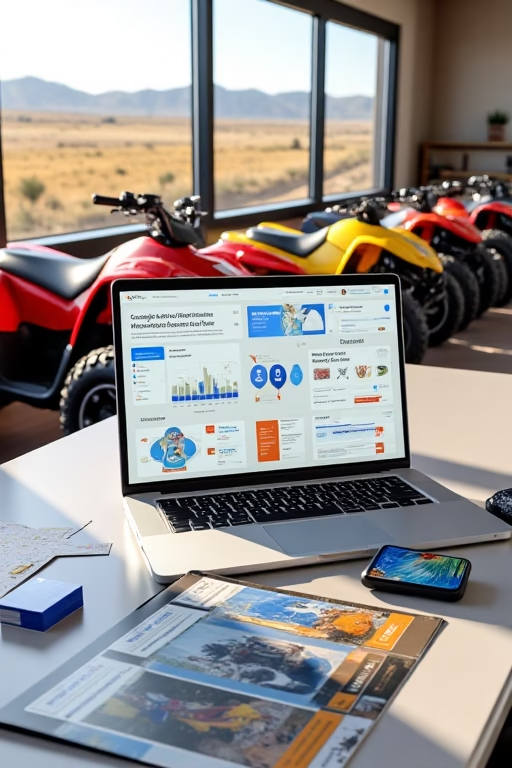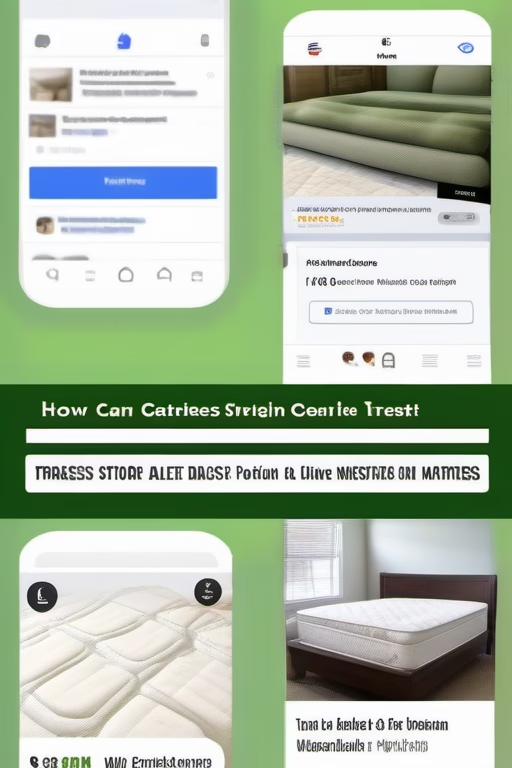SEO for ATV Businesses: How to Rank Locally
Local SEO is a powerful tool for ATV dealerships, service centers, and rental businesses looking to stand out in search results and attract customers in their area. Whether you target off-road enthusiasts, farmers in need of utility vehicles, or outdoor adventurers, optimizing your online presence ensures potential buyers can find you quickly. This guide delves into proven local SEO strategies, from optimizing Google Business profiles to leveraging content marketing. By implementing these tips, ATV businesses can gain higher visibility, drive qualified leads, and build a lasting local reputation.
In this blog, we’ll cover:
- Why local SEO matters for ATV businesses
- Optimizing your Google Business Profile and website for local searches
- On-page and off-page SEO strategies tailored to powersports
- Success stories from ATV companies that have dominated local SERPs
- Key metrics for tracking SEO success
- Frequently asked questions to address common local SEO concerns
Table of Contents
- 1. Why Local SEO Matters for ATV Businesses
- 2. Optimizing Your Google Business Profile
- 2.1 Creating and Verifying Your Profile
- 2.2 Complete Profile Optimization
- 2.3 Managing and Encouraging Reviews
- 3. Website SEO for Local ATV Dealers
- 3.1 Local Keyword Research and Placement
- 3.2 On-Page SEO Tactics
- 3.3 User Experience and Mobile Friendliness
- 4. Leveraging Content Marketing to Boost Local Visibility
- 5. Local Links and Citations
- 5.1 Directory Listings and Data Aggregators
- 5.2 Niche Powersports Citations
- 5.3 Sponsorships and Community Events
- 6. Tracking and Analytics
- 6.1 Tools for Monitoring Local SEO Progress
- 6.2 Key Metrics: Traffic, Conversions, Engagement
- 6.3 Continuous Optimization and Strategy Adjustments
- 7. Case Studies: ATV Businesses That Nailed Local SEO
- 8. Common Local SEO Pitfalls to Avoid
- 9. Conclusion
- 10. Frequently Asked Questions (FAQ)
- 11. 25 Additional Keywords
1. Why Local SEO Matters for ATV Businesses
Local SEO focuses on optimizing your online presence for location-specific searches. Whether someone’s searching for “ATV dealer near me” or “best off-road vehicle in [Your City],” a well-crafted local SEO strategy ensures your business surfaces at the top of results. This can drastically increase foot traffic, phone calls, and overall conversions.
1.1 Customer Behavior and the Importance of Local Searches
In recent years, more consumers rely on search engines to find local solutions, especially for specialized products like ATVs. Prospective buyers often do preliminary online research before ever stepping into a dealership. Capturing attention in local SERPs (Search Engine Result Pages) is crucial to funnel them toward your business instead of a competitor.
- Mobile Dominance: Many searches happen on smartphones, making local SEO even more pivotal as users often add “near me” or rely on location-based services.
- Immediate Needs: People searching for “ATV repair near me” likely want quick solutions. Ranking highly ensures your phone rings first.
- Example: A user needing a specific ATV part in an emergency might pick the top listing in local results, emphasizing how local ranking can win crucial, time-sensitive business.
1.2 Gaining an Edge Over Competitors
In many locales, only a handful of ATV dealers or service shops exist. Effective local SEO can help you stand out, especially if your rivals aren’t as digitally savvy. By ranking higher, you can secure a larger market share even without a sprawling marketing budget.
- First Impressions Count: People often trust top search results more than lesser-ranked ones, associating better rank with better service.
- Lower Advertising Costs: Organic search listings can reduce reliance on paid ads, saving your business money.
- Example: If your store is the only one with optimized Google Business listings, high-quality reviews, and updated social channels, local customers are more likely to pick your store over a competitor’s low-profile web presence.
2. Optimizing Your Google Business Profile
A Google Business Profile (GBP)—formerly Google My Business—is arguably the most critical tool for local ATV SEO. When prospective buyers in your area search for ATV dealers or service centers, your GBP can show up in the Local Pack, Google Maps, or general SERPs, providing crucial info at a glance.
2.1 Creating and Verifying Your Profile
If you haven’t already, claim your business on Google. Google will typically send a postcard or other verification method to confirm your address. This ensures your listing is legitimate and provides you with control over the profile’s content.
- Accurate Address: Use consistent formatting and ensure it matches your website, local directories, and citations.
- Primary Category: Choose “ATV Dealer,” “Powersports Dealer,” or a similarly relevant category for maximum visibility.
- Example: If your store is called “Off-Road Solutions,” keep that exact wording across your Google Business listing, your website’s footer, and any local directories to avoid confusion.
2.2 Complete Profile Optimization
A fully filled out Google Business Profile (GBP) can be the deciding factor for a local searcher. Provide as much detail as possible.
- Accurate Hours: Include seasonal hours if your store changes them (e.g., extended summer hours). Keep them updated to avoid customer frustration.
- Photos and Videos: Post images of your showroom, top ATV models, staff, and any events. If possible, add short videos of your lot or test rides to reflect an active presence.
- Services/Products Section: List specific ATVs or service packages. This helps Google match your listing with relevant queries (“ATV engine repair,” “sport ATV sales,” etc.).
- Example: A dealership that includes a “Kawasaki KFX90 Sale” within their GBP updates signals relevance for those searching for that model specifically.
2.3 Managing and Encouraging Reviews
Positive reviews influence local pack rankings and shape buyer perceptions. Encourage satisfied customers to share their experiences, while addressing negative feedback proactively.
- Request Feedback: Prompt in-person or via email for reviews, especially after a successful purchase or service experience.
- Timely Responses: Thank positive reviewers, address concerns from critical reviews, and maintain professional courtesy.
- Example: A prompt like “We’d love your feedback on Google!” on your sales invoice or follow-up email can gently push customers to share their experience, boosting your review count.
3. Website SEO for Local ATV Dealers
While a polished Google Business Profile is vital, your website is your brand’s digital home base. Implement local SEO best practices to rank for relevant queries and guide visitors seamlessly into your sales funnel.
3.1 Local Keyword Research and Placement
Identify the specific search terms prospective buyers use. Terms like “ATV dealership in [City],” “4x4 for sale near me,” or “[Brand] dealer [Zip Code]” often yield high-intent traffic.
- Location-Specific Phrases: Integrate city, region, or neighborhood references in headings, meta tags, and content, e.g., “Serving the [City] area for 10+ years.”
- Long-Tail Keywords: More descriptive queries like “best ATV for hunting near [City]” can attract targeted buyers seeking specialized info.
- Example: A homepage title might read “Your Trusted ATV Dealer in Omaha, NE | Premium Off-Road Vehicle Sales” for immediate local relevance.
3.2 On-Page SEO Tactics
On-page optimization helps search engines interpret your website’s structure and relevancy. Tweak key elements to highlight your location-based services.
- Meta Titles and Descriptions: Summarize each page’s content with local references. Keep them within recommended character limits.
- Header Tags (H1, H2, etc.): Outline content clearly and integrate local keywords naturally.
- Internal Linking: Link from your homepage to service-specific or product-specific pages with descriptive anchor text, e.g., “Check out our ATV repair services in [City].”
- Example: A “Services” page could have separate sections for “Maintenance for [City] ATV Owners,” “ATV Engine Repair near [Zip Code],” etc. to target localized queries.
3.3 User Experience and Mobile Friendliness
Search engines value user experience. If your site loads slowly or is awkward on smartphones, visitors will bounce—hurting your rankings and conversion rates.
- Responsive Design: Ensure the site automatically adjusts to various screen sizes, letting users browse inventory or service info easily.
- Fast Loading: Compress images, use caching, and streamline code for quick page loads. Tools like Google PageSpeed Insights can identify improvements.
- Clear Navigation: Group products, services, or info by categories to help visitors find what they need fast (e.g., “Sport ATVs,” “Utility ATVs,” “Parts and Accessories”).
- Example: Potential buyer on mobile who quickly sees “Current Inventory,” “Parts & Services,” or “Schedule a Test Ride” tabs is more likely to take further action.
4. Leveraging Content Marketing to Boost Local Visibility
Engaging, educational content signals authority to both potential customers and search engines. By creating relevant posts, guides, or videos, you can highlight your expertise, keep visitors on your site longer, and attract high-intent traffic.
4.1 ATV-Specific Topic Ideas
Choose content themes that resonate with your local clientele. Always tie them to your region or highlight local trails, events, or community aspects if possible.
- Local Trail Guides: “Top 5 Off-Road Trails near [City],” featuring recommended routes, scenic points, or difficulty levels.
- Maintenance Tips: Seasonal care guides or “how to prep your ATV for winter in [Location’s climate].”
- Upgrading Advice: Explain aftermarket parts or accessories that suit region-specific conditions (e.g., deeper tread tires for muddy farmland).
- Example: “Your Ultimate Guide to ATV Riding in [State]: Best Trails and Must-Have Gear” can rank for queries from local thrill-seekers planning their next ride.
4.2 Blogging and Link-Building Tips
A regularly updated blog keeps your site fresh, which search engines favor. Furthermore, well-researched posts can attract backlinks from local news outlets, forums, or niche sites.
- Guest Posts: Pitch content to local or niche powersports publications, linking back to your site. This signals authority and expands reach.
- Infographics and Data: Summaries of local ATV usage stats or “top reasons to choose an ATV in [area].” Visual data often invites shares.
- Community Collaboration: Collaborate with local clubs or event organizers, possibly cross-promoting articles or event recaps. This synergy fosters new inbound links.
- Example: A highlight reel or Q&A with a local off-road racing champ featuring your brand or dealership can earn authoritative links from motorsport blogs or local newspapers covering the event.
4.3 YouTube and Video Content
Powersport enthusiasts love visuals. Short videos or detailed reviews can rank in Google’s universal search results, broadening your discoverability.
- ATV Model Walkthroughs: Showcase pros, cons, and unique features in a casual, relatable tone.
- Trail Rides or Event Coverage: Document group rides or local races, peppering in subtle dealership or brand mentions.
- SEO for YouTube: Use local keywords in titles, descriptions, and tags (e.g., “ATV Race in [City]” or “How to Service Your ATV in [Region]”).
- Example: A short “Farm Use ATV” demonstration video explaining how a particular model’s cargo capacity suits ranchers in [Location], posted on YouTube with relevant metadata, can show in local SERPs for farm-ATV queries.
5. Local Links and Citations
Building a network of local references (citations) and inbound links ensures search engines see your business as a relevant, established presence in your area. These digital endorsements strengthen your site’s local authority.
5.1 Directory Listings and Data Aggregators
Listing your ATV business in reputable local directories, niche powersports directories, and aggregator sites fortifies local SEO. Consistency of your NAP (Name, Address, Phone) across all platforms is key.
- High-Quality Directories: Yelp, Yellow Pages, or specialized off-road directories. Avoid spammy, low-quality ones.
- Identical NAP: The same spelling, abbreviations, and phone number must appear on every listing to avoid SEO confusion.
- Aggregators: Services like Localeze or InfoGroup feed data to search engines. Ensuring accurate info here can rectify or reinforce local data widely.
- Example: Double-check that “123 Main St.” isn’t spelled differently as “123 Main Street” in other directories, or search engines might see them as separate entities.
5.2 Niche Powersports Citations
Beyond mainstream directories, specialized platforms dedicated to motorcycles, ATVs, or off-road sports can yield highly targeted leads and potent link equity.
- Forums and Clubs: If permissible, include your dealership link in your forum signature or business profile on off-road community sites.
- Industry Associations: Many local or national powersports associations list member businesses in an online directory.
- Example: Being listed on “Local ATV Enthusiasts Club - Trusted Dealers” or similar niche organizations can significantly enhance your local SEO signals.
5.3 Sponsorships and Community Events
Partnering with local events, charities, or sporting activities fosters brand awareness and typically includes a website link on event pages. These local inbound links are powerful trust signals for search engines.
- Off-Road Rallies: Sponsor a local rally, ensuring your brand’s mention on promotional materials and event websites.
- Benefit Rides: Host or support charity rides, earning local press coverage and authoritative backlinks from news sites.
- Example: A mention on a local news site covering the “Annual ATV Safety Workshop, sponsored by [Your Dealership],” can provide a significant SEO boon and brand goodwill.
6. Tracking and Analytics
Data-backed insights form the backbone of successful local SEO efforts. By continuously monitoring traffic sources, keyword rankings, and conversions, you can adapt and refine your strategies for maximum ROI.
6.1 Tools for Monitoring Local SEO Progress
A variety of platforms and software can help you measure local search performance, check listing consistency, and identify improvement opportunities.
- Google Search Console: Tracks keyword queries, CTR, and site index status. Vital for diagnosing site issues or ranking improvements.
- Google Analytics: Monitors traffic volume, user demographics, bounce rates, and conversions from local queries or campaigns.
- Rank Trackers: Tools like BrightLocal or SEMrush’s local rank feature can verify how well you rank for region-specific keywords.
- Example: Observing a jump in “farm ATV near me” queries leading to your site indicates your content or local pages effectively target that niche term.
6.2 Key Metrics: Traffic, Conversions, Engagement
Basic traffic numbers don’t show the full picture; focus on how visitors interact, convert, and even re-engage.
- Local Traffic Share: Percentage of visitors from your region. A high local share suggests your campaigns effectively reach local prospects.
- Lead Generation: Form submissions, calls, or test ride bookings reflect your site’s conversion prowess. You can measure calls from your Google Business listing or track form completions as well.
- Engagement Metrics: Time on page, pages per session, or bounce rate can signal content relevancy or site usability issues.
- Example: A sudden rise in test ride requests from new users in your region is a strong indicator that local SEO updates are working effectively.
6.3 Continuous Optimization and Strategy Adjustments
Local SEO is not a set-it-and-forget-it affair. Algorithm updates, shifts in buyer preferences, and new local competitors all necessitate regular fine-tuning of your approach.
- Review Monthly or Quarterly: Audit your local rankings, check your Google Business listing for any needed updates, or reevaluate your content strategy.
- Customer Feedback Loops: If you notice repeated queries about location, shipping, or test drives, integrate solutions into your content or landing pages to streamline user journeys.
- Example: Adjusting your service pages if you notice an uptick in interest for “ATV custom modifications” in your analytics can preempt buyer questions, increasing conversions.
7. Case Studies: ATV Businesses That Nailed Local SEO
Real-world success stories illuminate how strategic local SEO has driven tangible results for ATV-focused companies. Below are two succinct examples: one for a small independent dealership and another for a multi-location brand.
7.1 Small Dealer Success
A single-location ATV dealer in a rural area restructured their site around “ATVs for farm work” and “off-road trails,” integrated local keywords referencing their surrounding counties, and launched a blog featuring regional trail advice. They also ensured consistent NAP (Name, Address, Phone) citations across multiple local directories. As a result, within six months, they saw a 60% boost in organic local traffic and a 30% lift in in-store foot traffic, mostly attributed to improved ranking for queries like “ATV sales near [Town].”
- Highlights: Strategic content targeting farm tasks, consistent citations, fresh blog material.
- Lesson Learned: Even in rural settings with fewer direct competitors, local SEO can significantly expand your reach by connecting new customers who otherwise might not discover you online.
7.2 Multi-Location ATV Brand
A regional brand with four dealership locations used location-specific landing pages (e.g., “Yamaha ATVs in [City A],” “Polaris ATV Parts in [City B]”) and heavily promoted their Google Business Profiles for each store. They garnered consistent 4+ star ratings by encouraging customers to leave feedback. Over a year, they increased their local pack presence across all four areas, with each location ranking in the top 3 for its city’s “ATV dealership” search. Sales soared 40%, largely due to organic lead generation from top local SERP placements.
- Highlights: Individual GBP listings, city-targeted sub-pages, robust review strategy.
- Lesson Learned: Distinguishing each store’s identity and focusing on local sub-pages fosters better local keyword coverage and fosters trust among region-specific customers.
8. Common Local SEO Pitfalls to Avoid
Even the best-intentioned local SEO plans can stumble over certain common mistakes. Below are pitfalls to sidestep for smoother results:
- Inconsistent Business Info: Differing addresses or phone numbers across directories confuses search engines, hindering rank.
- Neglecting Reviews: Failing to respond to or encourage user reviews can hamper local conversions and hamper brand perception.
- Overstuffing Keywords: Attempting to force too many location-based terms can appear spammy and reduce content readability.
- Ignoring Mobile Performance: A site that isn’t mobile-friendly risks high bounce rates from on-the-go local searchers.
- Stopping After Quick Wins: Local SEO is ongoing. Periodic updates, new content, and consistent citation checks keep your momentum going.
9. Conclusion
Local SEO can be a game-changer for ATV businesses vying for dominance within a specific region. Whether your customers are outdoor adventure seekers, farmers, or off-road sports enthusiasts, robust local SEO ensures you remain visible to individuals actively searching for ATVs or related services in your area. By focusing on a comprehensive Google Business Profile, well-optimized on-page content, strategic link building, and consistent updates, your brand can outmaneuver competitors and capture a loyal local following.
Remember that success relies on regular monitoring, learning from analytics, and adapting your strategy to market shifts. As you accumulate positive reviews, fresh local content, and a strong presence on directories, your business will see improved SERP positions and a noticeable uptick in quality leads—ultimately translating into more showroom visits, phone calls, and, of course, ATV sales.
10. Frequently Asked Questions (FAQ)
1. Why is local SEO essential for an ATV dealership?
Local SEO helps your dealership appear in location-based queries. This ensures customers in your area can quickly discover your business when searching for ATVs or related services, rather than finding out-of-area competitors or irrelevant results.
2. How can I improve my Google Business Profile ranking?
Fill out every field with accurate data, use relevant keywords, upload high-quality photos and videos, and encourage positive reviews. Maintain consistent business info across all directories, regularly posting updates and promotions if available.
3. Should I use city names in my website’s content?
Yes. Incorporating city or neighborhood references in headings, meta descriptions, and throughout text helps search engines associate your business with that location, improving local relevance.
4. How do I handle multiple dealership locations in different cities?
Create separate location pages on your website, each with distinct content and keywords. Also, manage individual Google Business profiles for each address to localize them properly.
5. Can I track which local keywords drive traffic to my ATV business site?
Yes, tools like Google Search Console, Google Analytics, and specialized rank-tracking software can provide insights into the terms people use to find you, helping refine your local SEO approach.
6. Is it important to have a blog for local SEO?
A blog helps you produce fresh content, targeting local keywords and user interests. Well-crafted articles can rank for long-tail queries, drawing in visitors looking for ATV advice, trail recommendations, or repair tips.
7. Do reviews affect local search rankings?
Yes, reviews significantly impact both ranking in the local pack and user trust. A high number of positive reviews, along with timely and courteous review responses, signal strong customer satisfaction to Google.
8. What if my market is smaller and I face little competition—does SEO still matter?
Yes. Even with minimal direct competition, local SEO ensures new or relocating customers discover your dealership. Plus, your efforts secure early dominance, making it harder for future competitors to outrank you.
9. How can I optimize for voice searches like Siri or Alexa?
Focus on conversational keywords, often question-based (e.g., "Where can I buy an ATV near me?"). Structured data, clear site navigation, and a well-optimized Google Business profile also help.
10. Should I create separate pages for different ATV models?
Yes, especially for sought-after or new models. Dedicated pages targeting local keywords can rank for those specifics (e.g., “Yamaha Grizzly for sale in [City]”). This also helps prospective buyers easily find model details.
11. How often should I update my site’s content?
Regular content additions or revisions (blogging, new pages, event updates) keep the site fresh. Search engines appreciate active sites, so posting monthly or even weekly can maintain SEO momentum.
12. Are backlinks from local clubs or sports events valuable?
Absolutely. Local or community-based links are typically considered more authentic and relevant, enhancing both local authority and brand recognition in the community.
13. What if my business also sells parts or offers repairs—should I have specific pages for each service?
Yes, service-specific pages with localized titles (e.g., “ATV Part Sales in [City],” “[City] ATV Engine Repair”) can capture more targeted queries, improving your site’s visibility across multiple verticals.
14. Does social media activity affect local SEO directly?
While social signals aren’t direct ranking factors, active social media can boost brand awareness, generate traffic, earn backlinks, and encourage user engagement—indirectly contributing to better SEO outcomes.
15. Should I embed Google Maps on my contact or location page?
Yes. Embedding a map helps search engines correlate your physical address with your site content. It also benefits visitors by providing a direct route for directions or commuting info.
16. What can I do if I receive a negative online review?
Respond promptly and professionally. Show empathy, address the issue, and suggest a resolution. Potential customers appreciate a business that respectfully handles criticism, improving your perceived trustworthiness.
17. Are paid ads necessary if I focus on local SEO?
They’re not mandatory, but combining local SEO with geo-targeted Google Ads or social ads can rapidly boost visibility—especially during promotions or new model launches. SEO success typically provides more sustained, long-term benefits.
18. How can I optimize my site for multiple nearby towns or regions?
Create location-based pages or mention multiple areas in your content. But ensure each page provides unique value—don’t just duplicate text while swapping out city names, as search engines might penalize that as spammy.
19. What if my site is brand-new—how quickly can I rank locally?
Local SEO improvements can yield noticeable results in a few months, but it varies. Google’s trust in a new domain builds over time, so consistent updates, link building, and positive signals accelerate progress.
20. How do I handle duplicate addresses or phone numbers for multiple locations?
Each location page (and GBP listing) should list the address unique to that store. If multiple dealerships share one phone line, it’s best to have distinct direct lines or at least extensions for each location to avoid confusion in local data.
21. Does hosting provider location matter for local SEO?
Generally, no. Speed and uptime matter more. If your hosting is slow or inconsistent, it negatively impacts user experience. That said, a local or national server might help reduce load times for domestic visitors.
22. What’s the benefit of creating question-and-answer content about ATVs?
Q&A or FAQ pages rank well for voice searches and long-tail queries, establishing your authority while capturing visitors seeking immediate, direct answers about ATV features, maintenance, or local laws.
23. Should I incorporate local events or meetups on my site?
Yes. Hosting or promoting local ATV meetups, charity rides, or demos fosters community engagement and can secure local backlinks, building brand recognition and SEO value.
24. How do I handle seasonal changes in my local SEO strategy?
Adjust your content, promotions, and emphasis to reflect off-season deals, winterization services, or new spring arrivals. Refresh homepage banners, titles, and blog topics accordingly to maintain relevance in each season.
25. Is it beneficial to use schema markup for local SEO?
Yes, local business schema markup clarifies your business details for search engines, possibly yielding richer SERP results (like showing business hours or star ratings), further enhancing local visibility.
11. 25 Additional Keywords
- SEO for ATV
- ATV Businesses SEO
- ATV Local SEO
- Rank Locally ATV
- Google My Business ATV
- Powersport SEO
- Off-Road Vehicle SEO
- Local Search Engine Optimization
- ATV Dealership Marketing
- ATV Service Center SEO
- High-Ticket ATV Buyers
- ATV Keyword Research
- Local Citations ATV
- On-Page SEO ATVs
- ATV Google Maps Ranking
- ATV Web Presence
- ATV Blogging
- ATVPro SEO
- Local Marketing ATVs
- ATV Search Visibility
- ATV Customer Engagement
- ATV Digital Marketing
- ATV Online Listings
- ATV Industry SEO
- ATV SERP Ranking

















